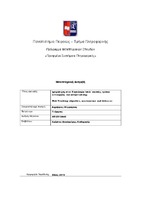Ιχνηλάτηση στον Παγκόσμιο Ιστό : σκοπός, τρόποι λειτουργίας και αντιμετώπισης
Web tracking : objective, mechanisms and defenses

View/
Keywords
Διαδίκτυο (Internet) ; Web tracking ; Παρακολούθηση χρηστών ; FingerprintingAbstract
In the recent years, the efforts of web services have focused on the acquisition of as more information related to their users as possible. This information is usually related to the content of users’ online searches, the kind of websites they visit, the people they come in touch and the products they buy online. The tracking of the users, in most of the cases, is performed by content or service providers for purely commercial reasons. In reality though, it has been proven that web tracking is used by different carriers for various reasons. The acquired information is not always used directly by the carrier itself. A very common practice is the collected data to be sold to third parties, such as insurance companies or e-shops. There are also cases that government services or identity thieves get access to this data. It is therefore obvious that privacy constitutes the Achilles' heel of today’s web. Users’ web tracking can be performed in many ways. For this reason, many mechanisms, which can be grouped to categories, have been developed, among which remarkable are the ones which are based exclusively on browsing, on storage, on cache memory (web or operational), on fingerprinting and more. All these tracking mechanisms’ target is the online recognition of users and the connection with their real identity attributes, such as name, home address, phone number, email address etc. The revelation of all this information may have consequences which are sometimes unpleasant for the users. Thus, the challenge ahead is how users’ web tracking can be tackled. From time to time, many different approaches have been presented, some of which are focusing on a specific web tracking mechanism, whereas others are more generic. The main goal of the present thesis is the research and the register of recent web tracking methods, the presentation of their goals and working ways, as well as the analysis of ways to address them. For this reason, this thesis is divided in three basic parts. In the first part there is a generic presentation of web tracking, an analysis of the purposes of web tracking methods through the consequences that their implementation has for the users, as well as a brief mention of the impacts of web tracking on the users’ online privacy. In the second part, there is a synopsis of all known web tracking methods and mechanisms. In the third part, the possible ways of defenses are discussed through the approaches that have been presented from time to time for this purpose and also some thoughts and proposals for the future of web tracking. The thesis is completed with the presenting of conclusions drawn from the study.


